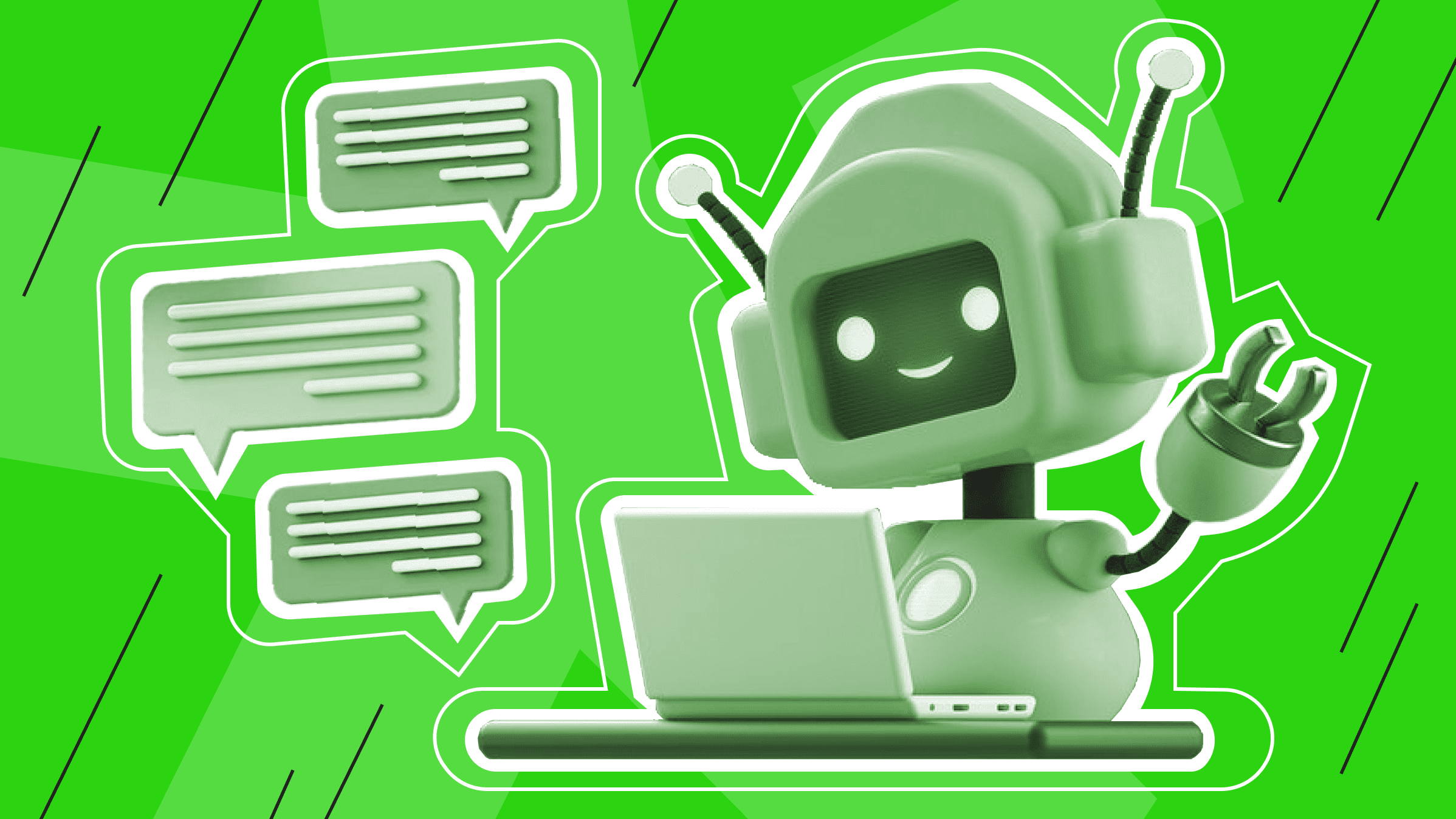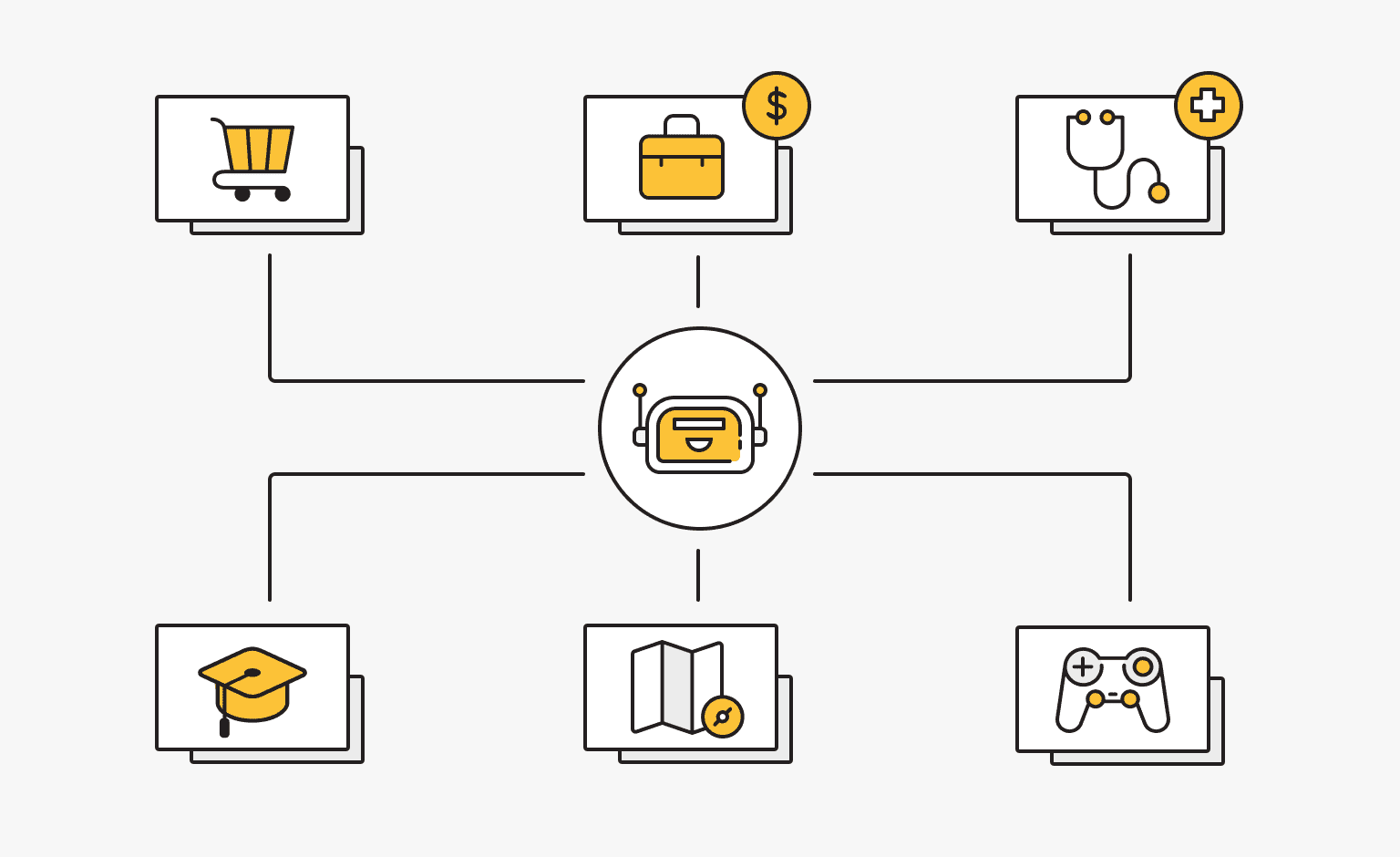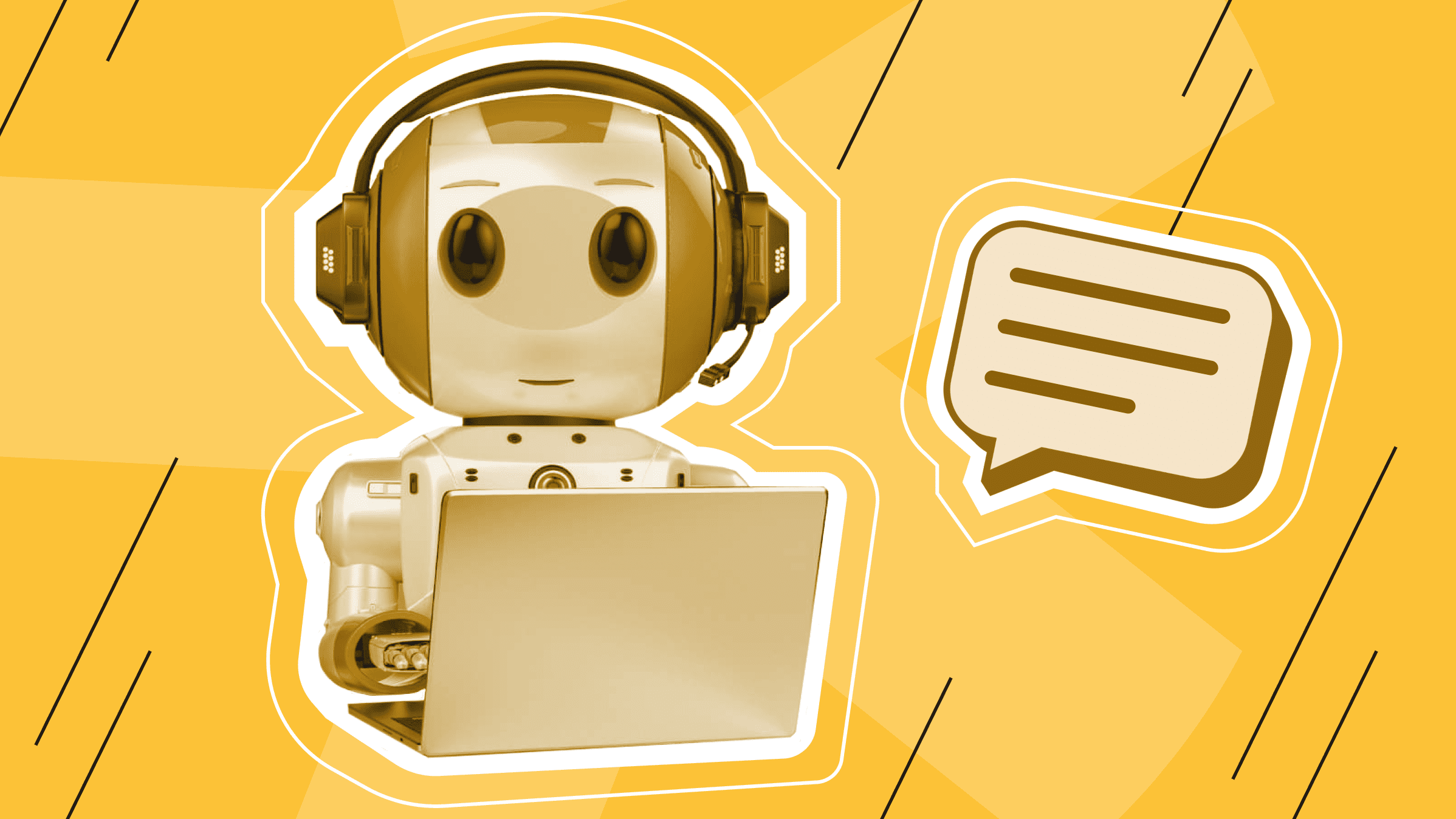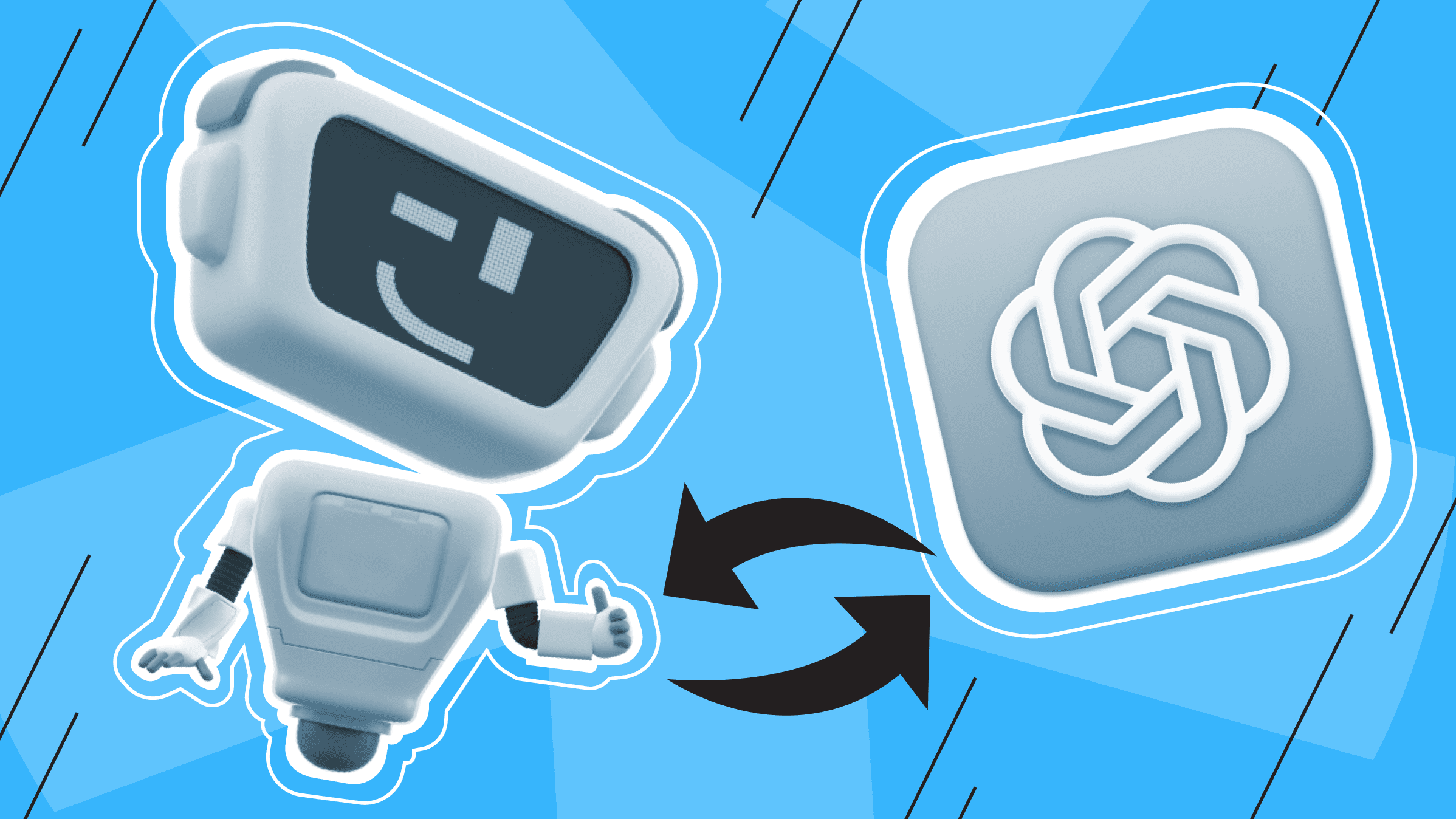
Each of us has encountered situations where, while researching a product online, a chat window appears on the screen offering assistance. We also frequently use mobile applications for ordering taxis that are based on a chat interface. Even calling a bank doesn't always involve speaking to an operator - it's enough to formulate a question simply, and you'll receive pre-prepared information. All of these situations are examples of chatbot usage. Chatbots have become so integrated into our lives that we sometimes don't even notice their presence.
In this article, we will explain what a chatbot is, what lies at the core of this technology, and how the use of chatbots is changing our reality.
What Is a Chatbot?

A chatbot is a computer program that mimics human communication (both verbal and written) and allows users to interact with digital devices as if they were communicating with a real person. Today's chatbots are powered by artificial intelligence (AI) systems that use deep learning and natural language processing techniques to carry on conversations and mimic the interlocutor's behavior.
Recently, chatbots have grown dramatically in popularity. Notable examples include OpenAI's ChatGPT, Microsoft's Bing Chat (built on OpenAI's GPT-4) and Google's Bard. These products are built on large language models that are customized for specific tasks or applications, such as simulated conversation. Chatbots are also used in various technologies, such as virtual assistants like Amazon Alexa and Google Assistant, as well as messengers like WeChat and Facebook Messenger.
History of Chatbots
The evolution of chatbots began in 1950 when Alan Turing published an article entitled Computing Machinery and Intelligence. In that article, he introduced the concept of the Turing test for a computer's level of intelligence. The test involves a computer program conducting a real-time written conversation with a human judge and striving to mimic a human so convincingly that the judge cannot reliably distinguish the program from a real person based on the conversation alone.
Turing's idea sparked considerable interest in the development of chatbots, leading to the creation of the ELIZA program by Joseph Weitzenbaum in 1966. ELIZA had the amazing ability to fool users into believing they were communicating with a real person. It did this by using an approach that made it appear as if it understood the user's input and could generate meaningful responses.
This was accomplished by identifying clues in the user's input words or phrases and providing pre-prepared answers, thereby creating the illusion of understanding and developing a dialogue that seemed meaningful. For example, if the word "MOTHER" is found in the input, ELIZA may answer: "TELL ME MORE ABOUT YOUR FAMILY".
Throughout the 1970s, various versions of chatbots were created. The most notable of these was PARRY, developed in 1972 by Kenneth Colby, a professor of psychiatry at Stanford University. PARRY, like ELIZA, was a stimulus-response type chatbot, but it was aimed at mimicking a person with schizophrenia and had an additional built-in conversational strategy that extended its functionality.
PARRY and ELIZA had numerous conversations, most famously on September 18th, 1972, and these were early attempts to incorporate natural language processing into chatbots. Both chatbots passed a limited form of the Turing test for artificial intelligence, with PARRY fooling about 52% of the psychiatrists who analyzed his responses.
In 1995, Richard Wallace developed the chatbot by creating a program called ALICE, which was instrumental in further developing the industry. ALICE used the AIML markup language, which helped define the dialogue rules. But the real breakthrough came when ALICE's source code became open source.
The integration of artificial intelligence and the development of open-source chatbots has led to rapid progress and widespread adoption of this technology. Today, chatbots are actively used in companies worldwide as customer support services. Apple's Siri, Samsung's Bixby, Microsoft's Cortana, Google Assistant from Google, and Amazon's Alexa are all examples of chatbots that embody the idea of personal assistants.
A new artificial intelligence chatbot called ChatGPT, developed by DALL-E and GPT-3, appeared in 2022. OpenAI gave the public free access to ChatGPT while conducting research. ChatGPT allows users to create letters to their boss, explain complex topics, or get gift ideas by asking questions.
It should be noted that access to ChatGPT is limited in a number of countries. If you want to use ChatGPT and get access to all its benefits, you can use VPN from is*hosting, which will also ensure your online privacy.
Scope and Benefits of Using Chatbots

Chatbots have become a valuable asset to companies in various industries because of the range of benefits and variety of uses. In e-commerce and retail, chatbots are used as customer service agents, providing detailed product information, personalized recommendations, and assistance with order processing and returns.
Financial institutions such as banks use chatbots as agents to handle customer inquiries, provide account balances and statements, and assist with transactions.
In healthcare, chatbots are used for tasks such as scheduling appointments, providing medication information, and helping patients find nearby clinics.
In education, chatbots help with student feedback, teacher evaluations, and administrative assistance.
Chatbots act as interactive agents in the travel and hospitality industry, helping customers with ticketing, online check-in, and other logistics.
Chatbots also play an important role in personalizing gameplay. They can analyze each player's gaming style and suggest new levels and challenges based on previous game history.
Overall, chatbots improve operational efficiency and reduce company costs while providing convenience to internal employees and external customers. They streamline the process of handling a variety of customer requests and inquiries, reducing the need for human intervention. Let's take a closer look at the business and customer benefits of chatbots:
Multitasking and time-saving: Chatbots are capable of having multiple conversations simultaneously, serving thousands of customers. This exceptional multitasking greatly improves business efficiency and reduces customer wait times, providing fast and efficient service.
Proactive customer interaction: In the past, organizations have largely relied on passive customer interaction, waiting for customers to initiate contact themselves. However, with the advent of chatbots, organizations can take a proactive approach by initiating conversations and tracking customer behavior on websites and landing pages.
Monitor and analyze customer data: Chatbots play an important role in gathering feedback for every customer interaction, allowing businesses to improve the quality of their services and products and optimize their websites.
Improve customer interactions: Most companies already interact with their customers through social media. However, chatbots can make this interaction more interactive by providing a communication channel through which customers can interact without the stress of interacting with another person.
Access to global markets: Chatbots can respond to customer inquiries in multiple languages, and 24/7 access allows customers to use chatbots regardless of time of day or time zone.
Expanding your customer base: by asking guiding questions and providing relevant information to customers, chatbots can feed that data back to the sales team, thereby improving conversion rates and ensuring a smooth progression to purchase.
Evaluating lead quality: Chatbots can help sales teams determine the quality of leads using key performance indicators such as budget, timing and resources. This allows companies to avoid wasting time on customers whose acquisition costs may exceed potential benefits.
How Chatbots Work

In the past, chatbots functioned as interactive FAQs and were effective at addressing the specific questions they were trained to handle, but they could not handle more complex or unforeseen requests. Today's chatbots use natural language understanding (NLU) to determine user needs and advanced AI tools based on machine learning and deep learning. The machine learning algorithms used in chatbots can vary.
For example, if a user asks about the weather for tomorrow, a traditional chatbot might simply answer whether it's going to rain. However, an AI-based chatbot might also ask if the user wants to set an alarm clock to account for increased travel time due to rain.
Let's understand how today's chatbots work and what makes them indispensable helpers in today's world.
Types of Chatbots
Chatbots can be divided into two main types: rule-based chatbots and AI-based chatbots.
Rule-based Chatbots
Rule-based chatbots, also known as scripted chatbots, work based on a predefined set of rules. These chatbots act according to a certain script, and their responses are predetermined. There are two main types of rule-based chatbots: button-based chatbots and keyword-based chatbots.
Button-based chatbots: These are the most common type of rule-based chatbots. They engage in conversation with users by offering them predetermined answer choices and responding with pre-written messages. These answer choices are usually in the form of buttons.
The structure of such a chatbot can be represented as a decision tree. The starting point of the decision tree is the chatbot's initial message, usually a welcome message offering help. As a chatbot decision tree example we can see how a chatbot might say, "Hi, I'm a chatbot. How can I help you?" after "Hello".
Along with the initial message, the user is presented with response options, which are the branches of the decision tree that determine what to do next. To continue, the user chooses one of the choices offered.
Although button chatbots are relatively simple, they can perform a variety of tasks, including answering frequently asked questions, collecting and relaying user information, and connecting users with chat operators.
Advantages
- Stable and predictable responses
- Quick and easy development
- Versatility
Disadvantages
- Lack of flexibility
- Limited user interaction
- A high probability of a script that is too drawn-out
Keyword-based chatbots: These chatbots are similar to button chatbots in that their responses are predefined, but they are also capable of understanding user input. Unlike push-button chatbots, they don't rely on clarifying questions or decision trees to give the right answer. Instead, when the user asks a question, the chatbot immediately tries to suggest a solution based on the recognized keywords. If the bot can't find the right answer, it responds with something like, "Sorry, I don't understand. Please rephrase your question."
Keyword recognition is often used for database automation. Companies often use chatbots that suggest database articles to users based on keywords extracted from their questions. This tool greatly improves customer self-service and reduces help desk workload. How to store large amounts of data efficiently?
Advantages
- Simulation of a more natural conversation
- Ability to integrate with databases, allowing for real-time information extraction
- Higher level of customer service
Disadvantages
- Keywords may not be recognized correctly
- Information provided may not always match the request as a result of variability in user input
AI-based Chatbots

AI-powered chatbots use machine learning and artificial intelligence to generate their own responses rather than relying on predefined scenarios. These chatbots use past customer interactions and previous learning results to understand the context and determine appropriate actions or responses. The learning process continues even after the chatbot is deployed, as it can continually self-learn based on new data from user interactions.
The ability of chatbots with artificial intelligence to generate their own responses allows for personalized communication and makes interaction more natural. However, this autonomy also means that it can be more difficult to control the bot's responses and achieve the desired conversation outcome. Is AI threatening us?
Some chatbots with artificial intelligence are so advanced that conversations with them are very similar to conversations with real people. An example is Kuki (formerly known as Mitsuku), a chatbot that has won the prestigious Loebner Prize, an annual Turing test competition, four times.
Advantages
- More opportunities for personalization.
- Conversation as close as possible to that between real people
- Opportunity for autonomous learning and improvement based on the information received
Disadvantages
- More complex and expensive technology compared to other types of chatbots
- More difficult to predict the exact outcome of a conversation
Hybrid Chatbots
A hybrid chatbot uses rule-based components to handle specific scenarios or frequently asked questions. When a user's query matches a known pattern or falls within the scope of predefined rules, the chatbot can provide a quick and relevant response.
On the other hand, AI components in hybrid chatbots use natural language processing (NLP) techniques and machine learning algorithms to understand and generate responses to more complex and unpredictable user requests. These AI components can analyze the context, mood, and intent behind user requests, allowing for more dynamic and personalized interactions.
Advantages
- Using predefined rules for specific scenarios or frequently asked questions
- Using artificial intelligence and machine learning to handle complex and unpredictable user data
- A balance between control and flexibility in generating responses
- A versatile and robust conversational experience
Disadvantages
- Complexity and high development costs
- Integration challenges
- Need for ongoing training and refinement
- Limited understanding of certain context
Chatbot Components
Today's chatbots are based on sophisticated algorithms that allow them to process information in such a way that the interaction with the user mimics a human-to-human interaction as much as possible, and the resulting response corresponds to the query entered by the user.
- Natural Language Processing (NLP)
Natural Language Processing (NLP) is an area of artificial intelligence that allows chatbots to understand and interpret human language. NLP allows chatbots to decipher user input, whether written or spoken and extract meaningful information from it. This process involves several steps, including tokenization (splitting sentences into words or phrases), syntactic analysis (parsing grammatical structure), and semantic analysis (understanding the meaning of words and their relationships). NLP algorithms also tackle tasks such as named entity recognition, sentiment analysis, and language translation, further enhancing the chatbot's conversational capabilities.
- Machine Learning (ML)
Machine learning plays a crucial role in enhancing the intelligence and adaptability of chatbots. Using machine learning algorithms, chatbots can learn from past interactions, recognize patterns and continuously improve their responses. There are two main types of machine-learning techniques used in chatbots:
Supervised learning: In this approach, chatbots learn from labeled datasets that present the correct responses to various user actions. The model learns to generalize these examples, which allows it to generate appropriate responses.
Reinforcement learning: In reinforcement learning, chatbots interact with users or the simulated environment and receive feedback as rewards for correct responses or penalties for incorrect responses. Over time, the chatbot optimizes its actions to maximize cumulative rewards.
- Dialogue management
Dialogue management is the component responsible for handling the flow of conversations between the chatbot and users. It ensures consistency, contextual relevance, and ease of interaction. Chatbots use state-tracking mechanisms to maintain context throughout the conversation, remembering past interactions to provide more personalized responses. In addition, dialogue management includes techniques such as intent recognition, where the chatbot identifies the user's purpose or request in order to tailor its responses precisely.
- Integration with APIs and other platforms
To extend their capabilities and provide users with relevant information, chatbots often integrate with external APIs (application programming interfaces) and other platforms. APIs allow chatbots to access a wide range of data sources and services, such as weather information, flight details, product catalogs, or third-party applications. With this integration, chatbots can retrieve data in real-time and offer more complete responses, increasing their usefulness and relevance in different scenarios.
How Do I Create My Own Chatbot?

There are many tools available today that allow you to create your own chatbot. Some of these tools are designed for business use, such as streamlining internal operations, while others are focused on consumers.
The process of creating a chatbot is similar to developing a mobile app and requires a messaging platform or service. In addition, you may need your own server. is*hosting offers a variety of solutions for leasing dedicated or virtual servers that will help ensure uninterrupted operation of your web application, online service, or any other online resource. With chatbot creation tools available, you don't have to be an expert or developer to successfully accomplish this task. A product manager or business representative can use such tools to create their own chatbot in just a few hours. So, let's take a look at the basic steps of creating a chatbot:
- Planning and designing the chatbot
- Define the goal: clearly define the main task of the chatbot and identify the target audience. Determine what problems the chatbot will solve or what services it will offer.
- Choose a platform: determine whether your chatbot will be rule-based or AI-driven.
- Choose channels: define the platforms on which the chatbot will be available (e.g. website, messengers, social media) and adapt the design accordingly.
- Create the flow of the conversation: map out the flow of the conversation, taking into account the user's input and possible responses. Model different scenarios and create error-handling paths.
- Design the user interface: make sure the chatbot interface is intuitive, user-friendly and visually appealing.
- Choosing a platform to develop a chatbot
- Third-party chatbot development platforms: consider using popular platforms such as Dialogflow, Microsoft Bot Framework, or IBM Watson, which offer out-of-the-box tools and integrations.
- Custom development: if you need full control over the chatbot functionality and have the appropriate expertise, this might be a more suitable option.
- Natural Language Processing (NLP): make sure that the chosen platform supports NLP capabilities to understand and accurately process user input.
- Coding the chatbot
- Configure the environment: install the required development tools and libraries for the chosen platform.
- Define responses: implement conversation flow and integrate responses based on user input, considering both text and multimedia elements.
- Implement NLP: integrate NLP capabilities to analyze and interpret user messages effectively.
- Interaction testing: test the chatbot regularly as you write code to identify and fix any issues early in the development process.
- Testing and deployment
- Functional testing: perform comprehensive testing to make sure chatbot responses are accurate, relevant, and error-free.
- User testing: gather feedback from real users to identify usability issues and make necessary improvements.
- Deployment: deploy the chatbot on your chosen platforms and make sure it integrates seamlessly.
- Monitor and update: constantly monitor chatbot performance and user interactions. Analyze user feedback to make iterative improvements.
The Future of Chatbots

While chatbots bring numerous benefits to various industries and applications, they are not without their limitations and challenges. It is important to recognize these factors and work to overcome them in order to unlock the full potential of chatbot technology.
One significant limitation is the language barriers and cultural differences that arise when using chatbots. It can be difficult for them to accurately understand and respond to regional dialects and cultural nuances. Slang, idioms, and complex sentence structures create difficulties in providing contextually appropriate and accurate responses.
Another limitation is the lack of emotional intelligence in chatbots. Chatbots can effectively perform routine tasks and provide information, but they are unlikely to help in situations that require empathy and emotionality. Human connections and the ability to interpret complex emotions are aspects that are still difficult to replicate in automated systems.
Privacy and security issues also pose challenges to the implementation of chatbots. As chatbots work with sensitive user data, ensuring secure data storage, implementing strong authentication protocols, and enforcing data protection rules become critical aspects. Building trust and maintaining user privacy is paramount to successfully implementing chatbots.
Maintenance and updating are constant requirements in the development of chatbots. Conversation flow, responses and underlying technology require continuous improvement to keep up with changing user needs and technological advances. Regular updates and monitoring are necessary to ensure optimum performance and relevance.
Looking to the future, chatbots have great promise as AI and NLP continue to evolve. Artificial intelligence and natural language processing technologies are evolving rapidly, enhancing the ability of chatbots to understand and respond to user queries more accurately and naturally. Machine learning algorithms allow chatbots to learn and adapt based on user interaction, increasing their effectiveness over time.
In addition, chatbots are expected to integrate easily with voice assistants such as Amazon Alexa, Google Assistant or Apple Siri. This integration will increase their accessibility, allowing users to interact using voice commands and providing a more natural and comfortable interaction.
In addition to voice assistants, chatbots are also likely to expand their capabilities by integrating with IoT devices. This integration will allow chatbots to assist and control in various contexts, from smart homes to industrial automation.
Despite their limitations, chatbots have entered our lives, and the rapid development of AI and NLP technologies indicates that the future of chatbots is even more promising. While a few years ago, bots could only answer a limited number of questions and could rarely replace a live advisor, 67% of people now prefer to interact with chatbots.
VPS
Choose the suitable configuration and enjoy all the benefits of a virtual private server.
From $4.99/moDedicated Server
Smooth operation, high performance, and user-friendly setup - it's all there for you.
From $9.99/mo

